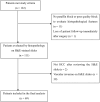Early Recurrence of Hepatocellular Carcinoma in Patients without Microscopic Vascular Invasion: Clinicopathological Characteristics and Risk Factors
- PMID: 40524873
- PMCID: PMC12168972
- DOI: 10.2147/JHC.S524683
Early Recurrence of Hepatocellular Carcinoma in Patients without Microscopic Vascular Invasion: Clinicopathological Characteristics and Risk Factors
Abstract
Purpose: Early recurrence of hepatocellular carcinoma (HCC) is not uniformly associated with microscopic vascular invasion (MVI). This study aims to identify the clinical and pathological factors associated with early recurrence in HCC patients without MVI.
Methods: A retrospective cohort study was conducted on 69 patients who underwent hepatectomy for HCC at the University Medical Center Ho Chi Minh city. All patients were microscopically confirmed as MVI-negative. Clinical and subclinical data, along with tumor recurrence within 24 months post-surgery were collected. Microscopic features of both tumor and non-tumor liver tissue were assessed using Hematoxylin-Eosin-stained slides.
Results: The majority of patients were male (78.3%) and had cirrhosis (72.5%). The early recurrence rate was 31.9%, with most recurrences occurring between 6- and 18-month post-surgery. Independent factors for early tumor recurrence included preoperative treatment with Transarterial Chemoembolization (TACE) or Radiofrequency Ablation (RFA) (HR = 8.63, 95% CI = 1.45-51.38), tumor size > 5 cm (HR = 3.82, 95% CI = 1.17-12.42), and HCV infection (HR = 4.61, 95% CI = 1.41-15.1).
Conclusion: The pathogenesis and pattern of early tumor recurrence in MVI-negative HCC differ from that in MVI-positive cases. Identifying risk factors, such as HCV infection, tumor size, and preoperative locoregional therapy, may aid in optimizing treatment strategies and postoperative surveillance.
Keywords: clinical characteristics; early recurrence; hepatocellular carcinoma; microvascular invasion; pathological characteristics; risk factor.
© 2025 Ngo et al.
Conflict of interest statement
The authors report no conflicts of interest in this work.
Figures
Similar articles
-
Tumor size larger than 6.5 cm and microvascular invasion are comparable prognosticators for hepatocellular carcinoma: a multi-institutional observational study.Clin Transl Oncol. 2025 Jul 10. doi: 10.1007/s12094-025-03981-3. Online ahead of print. Clin Transl Oncol. 2025. PMID: 40637946
-
Isolated Limb Perfusion Can Avert Amputation Indication in Initially Nonsalvageable Sarcomas of the Extremities.Clin Orthop Relat Res. 2025 Jun 19. doi: 10.1097/CORR.0000000000003584. Online ahead of print. Clin Orthop Relat Res. 2025. PMID: 40536544
-
[Joint analysis of invasive margins and tumor center to evaluate the prognostic value of bystander CD8+ T cells in early-stage non-small cell lung cancer].Zhonghua Zhong Liu Za Zhi. 2025 Jun 23;47(6):508-516. doi: 10.3760/cma.j.cn112152-20240805-00326. Zhonghua Zhong Liu Za Zhi. 2025. PMID: 40534266 Chinese.
-
Prevalence and odds of anxiety and depression in cutaneous malignant melanoma: a proportional meta-analysis and regression.Br J Dermatol. 2024 Jun 20;191(1):24-35. doi: 10.1093/bjd/ljae011. Br J Dermatol. 2024. PMID: 38197404
-
Prenatal administration of progestogens for preventing spontaneous preterm birth in women with a multiple pregnancy.Cochrane Database Syst Rev. 2019 Nov 20;2019(11):CD012024. doi: 10.1002/14651858.CD012024.pub3. Cochrane Database Syst Rev. 2019. PMID: 31745984 Free PMC article.
References
-
- Suraweera D, Konyn P, Vu T, Saab S. Clinical epidemiology of chronic liver disease: hepatocellular carcinoma. In: Wong RJ, Gish RG, editors. Clinical Epidemiology of Chronic Liver Diseases. Cham: Springer International Publishing; 2019:229–249.
LinkOut - more resources
Full Text Sources
Miscellaneous




